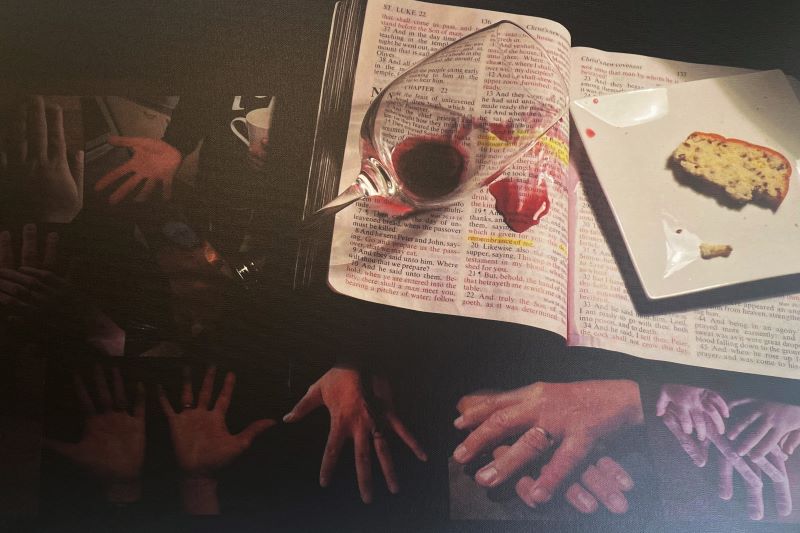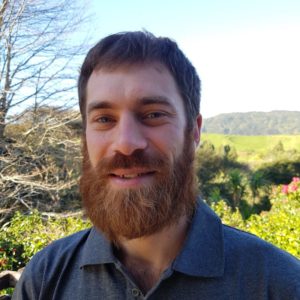Integrative Project: Jared Suisted
In the final year of our Bachelor of Applied Theology, students build a capstone research project, where they integrate the various modes of learning that they have gained. Student Jared Suisted painted this piece. He lives and serves in Ōpōtiki with his wife Jess, and children Michele and Asher, and in his project Jared set out to explore a way in which to generate growth within ageing congregations of New Zealand, basing this around the table. This artwork is rich in symbolism and reflects a model which Jared and his family are living out.
“God’s story in Ōpōtiki and beyond is yet to be finished.”

In this integrative project I set out to explore a way in which to generate growth within ageing congregations of New Zealand. In Part A of this project, I explored the decline of Christianity and the predominant growing trend of aging congregations in New Zealand. Part B then explored from a biblical perspective how the early Church connected over meals. In Part C we then turned our attention to St John’s Union Parish in Ōpōtiki and observed their communion practice. To conclude this project, I have created an artifact that incorporates the learnings from the exploration and research I have done and displays a model I believe is relevant and foundational for generating growth within ageing congregations.
This model has been shaped by three key observations from my research. Firstly, Kevin Ward observes a decline in Church attendance (and volunteer organisations) and highlights that more people have stopped belonging to a Church but still believe. Secondly, Dr Michael Grimshaw furthered Ward’s observations by asking “How can it [Church’s] relate to people under 40 who no longer have strong notions of progress, who question reason and rationality, and who distrust institutions and figures of authority.” Thirdly, Reta Haltman’s remark that within Church’s “a vertical element remains, but for most the horizontal element is missing.” These three key observations which are further supported by other scholars I have engaged with, have led me to conclude that one model that is relevant to generate growth in aging congregations is table fellowship. All ages can share a meal together and invite others along, building friendships and trust along the way. By eating together, we step away from strong figures of authority and lose the ‘institutional feel’ that a traditional structured church service might have. As people eat together, they start to open up and share their lives with one another, creating a sense of belonging and family over time. Table fellowship is at the heart of my chosen model.
My artifact:
My artifact rests on a table. While not easily seen in the image, the table is what families and friends gather around and is the key symbol of my model. The table is what holds it together in a practical sense. Most homes have a table and therefore bring a sense of place and familiarity to help create an atmosphere of unity as we meet.
“I am the light of the world” (John 8:12). The lamp which is unseen in my artifact but cast’s light across the project, represents Jesus being the true light, who gives insight, direction and hope. However, not all is visible to our eye…
The photos of hands represent those who we journey and dine with, and those who we hope to bring into fellowship with Jesus. Each person’s hand is part of a story that plays a part in God’s master book. The diversity of the hands (smooth, rough, clean, dirty, young, old) represents the diversity of people who should make up the Body of Christ, everyone. Some of the hands remain in darkness while others are illuminated by light, representing their journey towards God.
The unseen white canvas that the photos are sitting on symbolises right now. We cannot change the past. We know not what the future holds but we have right now. Slowing down and eating a meal together with face-to-face conversations in a technology-soaked world is needed. This ‘new model’ is actually looking back to a Biblical model to move forward in generating growth today. You cannot see either end of the canvas representing that we cannot see the start or end of God’s story but the light shines on us right now. So, what are we doing with that light?
The Bible, I purposefully chose the King James Version (KJV) as this project investigated how to generate growth amongst older congregations. The KJV is a little old fashioned for younger generations and while it still contains God’s word and truth, it serves to highlight this tension.
Bread conveys so much more than simply communion and what we have narrowed it down to mean. The bread represents the last supper and Jesus’ broken body, which is foundational to our belief. We can only find true unity and purpose because Jesus first offered Himself. Craig Keener highlights that bread most likely served as a “metonymy for a meal” and fellowship. The bread encompasses so much more and demands table fellowship.
The spilt wine represents Jesus’ blood poured out for us as believers but also for those who do not know Him yet. The significance of the blood being spilt over the project represents that life can be messy. The Bible may be written in black and white, but life is often lived out in grey. Yet it is through the ‘mess’ of Jesus’ blood that meaning and purpose can be found in life. The wine is spilt over Luke 22: 14-23, a passage that highlights Jesus as the ‘Head’ host, the one who invites all to come and dine with him regardless of who they are or what they have done. A reminder that the meals we facilitate are to point towards Jesus, not us. The spilt wine forms a heart further showing God’s heart for the lost. The wine running down the gutter of the Bible reminds us that it is God’s living Word and highlights the life and power of the Bible.
Finally, the artifact rests incomplete. Why? Because my wife Jess, our children Michele and Asher, and I are out there living this model. God’s story in Ōpōtiki and beyond is yet to be finished.


Love your story, the artwork and what it represents, Jared. Very challenging and appropriate. And indeed, it represents where we are at right now and the way forward. Blessings on you and family as you press forward.
With love and prayers,